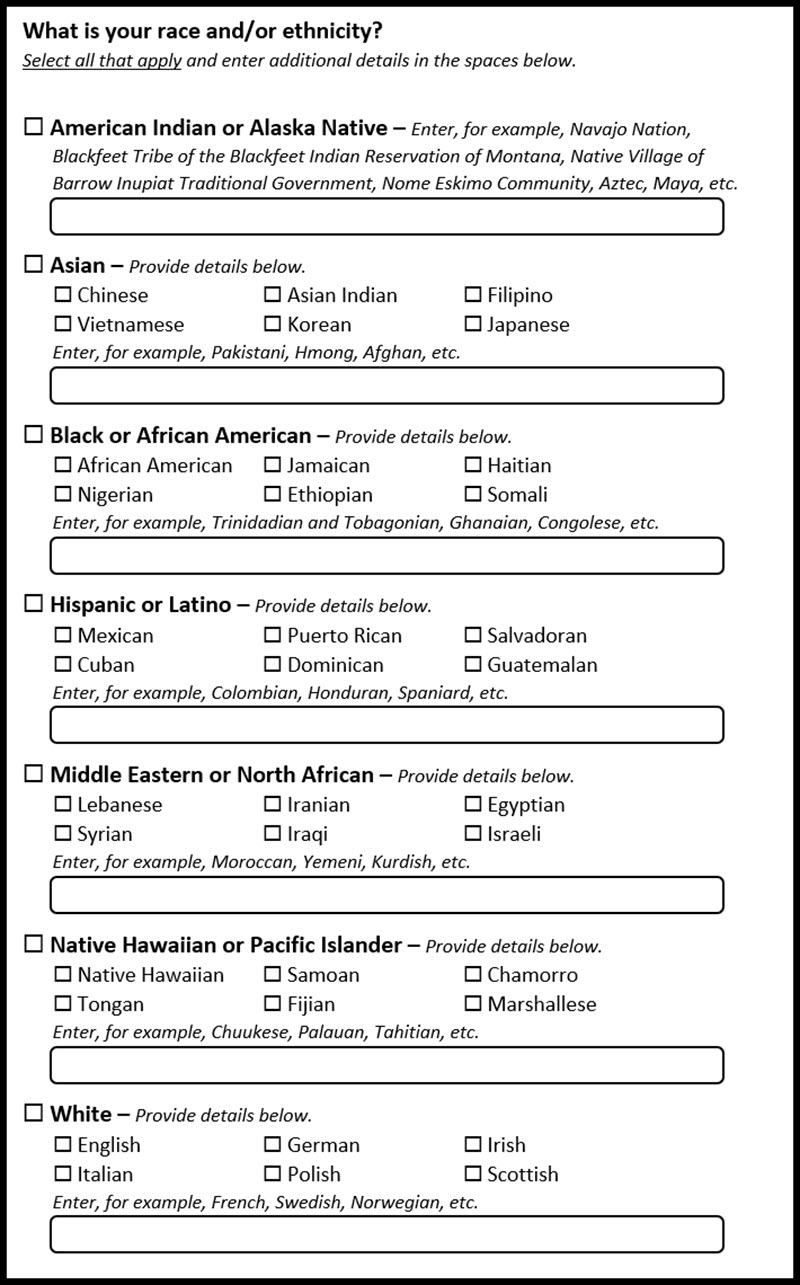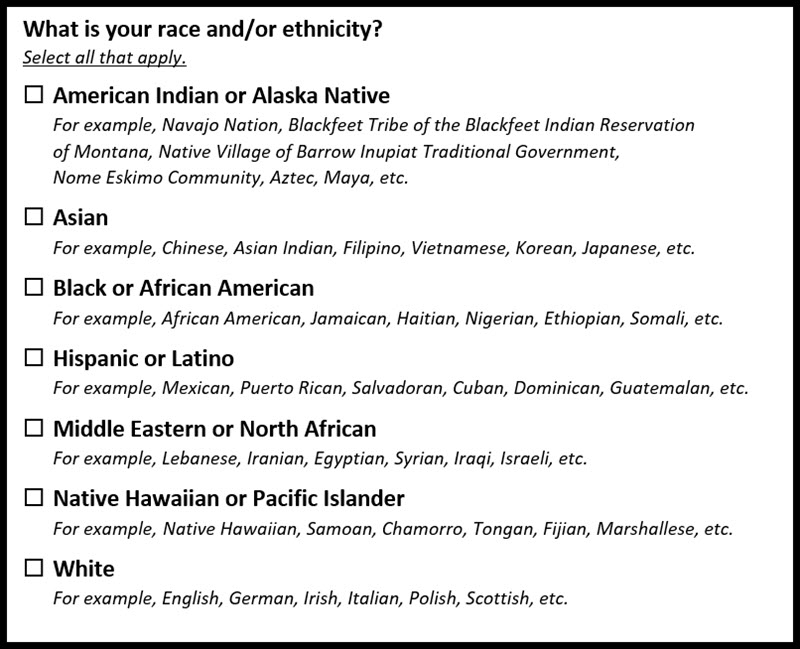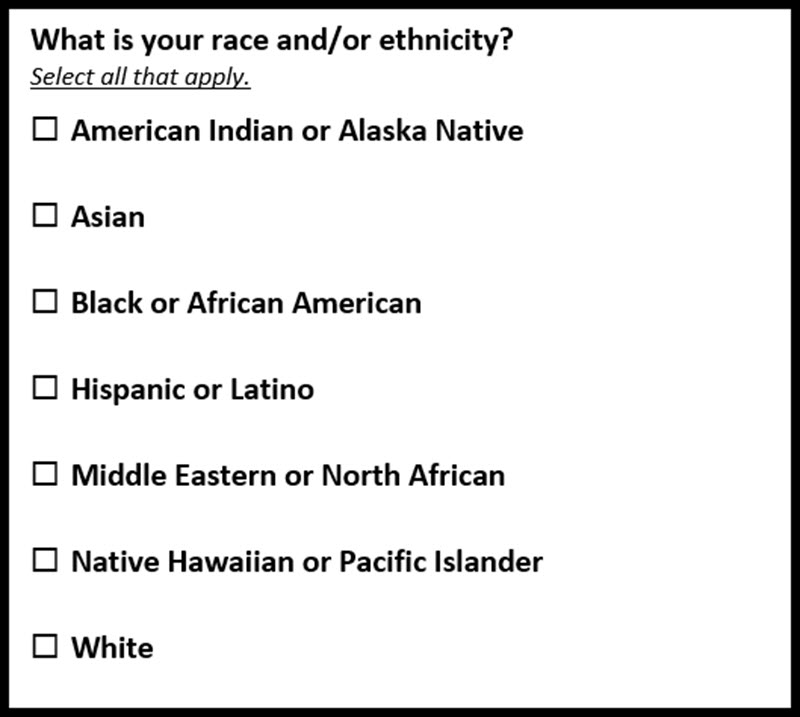2. Question Format
Combined question
A combined race and ethnicity question is required for both self-response and proxy data collection. Respondents shall be offered a single combined race and ethnicity question that allows them to select one category or multiple categories. A single selection will be considered a complete response (e.g., Hispanic or Latino respondents are not required to select an additional category).
Detailed responses
The revised SPD 15 requires the collection of detailed data on race and ethnicity beyond the minimum categories, unless an agency determines that the potential benefit of the detailed data would not justify the additional burden to the agency and the public or the additional risk to privacy or confidentiality, and therefore requests an exemption from the Office of Management and Budget’s (OMB) Office of Information and Regulatory Affairs (OIRA). In those cases, Federal agencies must at least use the minimum categories and justify this determination in the agency's PRA information collection review package. In cases where the data collection is not subject to the information collection approval process, a direct request for a variance shall be made to OMB through OIRA. Respondents must be offered the following detailed categories for the corresponding minimum categories:
American Indian or Alaska Native
- Providing a write-in field is especially critical for the American Indian or Alaska Native category, which does not have required detailed categories under these standards. The instructions for the write-in boxes should read: "Enter, for example, Navajo Nation, Blackfeet Tribe of the Black Indian Reservation of Montana, Native Village of Barrow Inupiat Traditional Government, Nome Eskimo Community, Aztec, Maya, etc."
Asian
- Chinese
- Asian Indian
- Filipino
- Vietnamese
- Korean
- Japanese
- Another group (for example, Pakistani, Hmong, Afghan, etc.)*
Black or African American
- African American
- Jamaican
- Haitian
- Nigerian
- Ethiopian
- Somali
- Another group (for example, Trinidadian and Tobagonian, Ghanian, Congolese, etc.)*
Hispanic or Latino
- Mexican
- Puerto Rican
- Salvadoran
- Cuban
- Dominican
- Guatemalan
- Another group (for example, Colombian, Honduran, Spaniard, etc.)*
Middle Eastern or North African
- Lebanese
- Iranian
- Egyptian
- Syrian
- Iraqi
- Israeli
- Another group (for example, Moroccan, Yemeni, Kurdish, etc.)*
Native Hawaiian or Pacific Islander
- Native Hawaiian
- Samoan
- Chamorro
- Tongan
- Fijian
- Marshallese
- Another group (for example, Chuukese, Palauan, Tahitian, etc.)*
White
- English
- German
- Irish
- Italian
- Polish
- Scottish
- Another group (for example, French, Swedish, Norwegian, etc.)*
* Whenever possible, the “Another group” detail category checkboxes should be replaced with write-in fields that allows respondents to self-identify as shown in Figure 1 below. The instructions for the write-in boxes should read “Enter, for example,” followed by the examples listed in parentheses above.
Instead of the detailed categories listed above and shown in Figure 1, agencies may use the detailed categories employed by the U.S. Census Bureau's most recently fielded American Community Survey. Any disaggregated data collected in addition to the detailed categories presented here (for example, a drop-down list for the American Indian or Alaska Native category) must be organized in such a way that the additional categories can be aggregated into the minimum categories. Any other variation to the detailed categories must be specifically authorized by OMB through the Paperwork Reduction Act (PRA) information collection approval process. In those cases where the data collection is not subject to the information collection approval process, a direct request for a variance shall be made to OMB through OIRA.
Question instruction
Respondents shall be offered the option of selecting one or more racial and ethnic designations. The question instructions will vary depending on whether there is a write-in field or if there are detailed categories as shown below. For questions with detailed categories and no write-in fields, the question instructions should read: "What is your race and/or ethnicity? Select all that apply." When write-in fields are provided, the instructions should read: "What is your race and/or ethnicity? Select all that apply and enter additional details in the spaces below." When collecting only the minimum categories, the question instructions should read "What is your race and/or ethnicity? Select all that apply."
| Question format | Write-in Fields? | Question Instructions |
|---|---|---|
| Detailed categories | No | “What is your race and/or ethnicity? Select all that apply.” |
| Yes | “What is your race and/or ethnicity? Select all that apply and enter additional details in the spaces below.” |
|
| Minimum categories | - | What is your race and/or ethnicity? Select all that apply.” |
Examples
The following three figures provide illustrative examples of question formats that comply with SPD 15. The standards do not specify the order that responses must be presented, but agencies typically order the responses alphabetically, as shown, or by population size. SPD 15 envisions that whenever possible agencies will collect race and ethnicity data with a question format that includes the required minimum categories disaggregated by the required detailed categories as illustrated in Figure 1.
Figure 1. Race and Ethnicity Question with Minimum Categories, Multiple Detailed Checkboxes, and Write-In Response Areas with Example Groups
When an agency receives an OIRA exemption from collecting detailed data, it may use a format that includes only the minimum categories, as shown in Figure 2 and Figure 3.
Figure 2. Race and Ethnicity Question with Minimum Categories Only and Examples
Figure 3. Race and Ethnicity Question with Minimum Categories Only
When using the minimum categories only, the quality of the data and consistency with other datasets may be improved by providing the respondent with examples as shown in Figure 2. Agencies should provide these examples when feasible over the example in Figure 3 without examples.
An official website of the U.S. Office of Management and Budget and the U.S. Census Bureau
Contact Us: Statistical_Directives@omb.eop.gov




